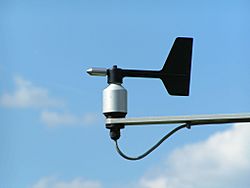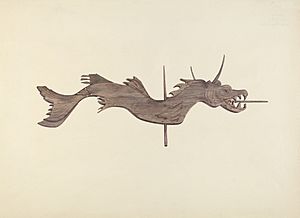Weather vane facts for kids
A weather vane is a device with a freely rotating pointer used to indicate the direction of the wind. Weather vanes served as simple devices for showing the direction of the wind and its speed for centuries. They were a critical tool for agriculture, travel and shipping. They serve a largely decorative function today. They have been replaced by specialized weather instruments.
To work correctly a weather vane should be at the highest point of a building. It needs to be as far away as possible from other things that might interrupt the wind. The simplest form is a horizontal arrow or other form freely rotating on a vertical rod. When the wind blows, the arrow shows the direction and speed. The earliest known weather was made by the astronomer Andronicus in 48 BC. It sat on top of the Tower of the Winds in Athens. It was between 4 feet (1.2 m) and 8 feet (2.4 m) long and was the shape of a head and torso of a man with the tail of a fish.
The word 'vane' comes from the Old English fana banner. This is related to the Old High German fano (cloth); from the Latin pannus (cloth or rag).
History
The oldest textual reference in China to a weather vane comes from the Huainanzi dating from around 139 BC, which mentions a thread or streamer that another commentator interprets as "wind-observing fan" (hou feng shin, 侯風扇). The Tower of the Winds on the ancient Greek agora in Athens once bore on its roof a weather vane in the form of a bronze Triton holding a rod in his outstretched hand, rotating as the wind changed direction. Below this was a frieze adorned with the eight Greek wind deities. The eight-metre-high structure also featured sundials, and a water clock inside. It dates from around 50 BC.
Military documents from the Three Kingdoms period of China (220–280) refer to the weather vane as "five ounces" (wu liang, 五兩), named after the weight of its materials. By the third century, Chinese weather vanes were shaped like birds and took the name of "wind-indicating bird" (xiang feng wu, 相風烏). The Sanfu huangtu (三輔黃圖), a third-century book written by Miao Changyan about the palaces at Chang'an, describes a bird-shaped weather vane situated on a tower roof.
The oldest surviving weather vane with the shape of a rooster is the Gallo di Ramperto, made in 820 and now preserved in the Museo di Santa Giulia in Brescia, Lombardy.
Pope Leo IV had a cock placed on the Old St. Peter's Basilica or old Constantinian basilica.
Pope Gregory I said that the cock (rooster) "was the most suitable emblem of Christianity", being "the emblem of St Peter", a reference to Luke 22:34 in which Jesus predicts that Peter will deny him three times before the rooster crows.
As a result of this, the cock gradually began to be used as a weather vane on church steeples, and in the ninth century Pope Nicholas I ordered the figure to be placed on every church steeple.
The Bayeux Tapestry of the 1070s depicts a man installing a cock on Westminster Abbey.
One alternative theory about the origin of weathercocks on church steeples is that it was an emblem of the vigilance of the clergy calling the people to prayer.
Another theory says that the cock was not a Christian symbol but an emblem of the sun derived from the Goths.
A few churches used weather vanes in the shape of the emblems of their patron saints. The City of London has two surviving examples. The weather vane of St Peter upon Cornhill is not in the shape of a rooster, but a key; while St Lawrence Jewry's weather vane is in the form of a gridiron.
Early weather vanes had very ornamental pointers, but modern weather vanes are usually simple arrows that dispense with the directionals because the instrument is connected to a remote reading station. An early example of this was installed in the Royal Navy's Admiralty building in London – the vane on the roof was mechanically linked to a large dial in the boardroom so senior officers were always aware of the wind direction when they met.
Modern aerovanes combine the directional vane with an anemometer (a device for measuring wind speed). Co-locating both instruments allows them to use the same axis (a vertical rod) and provides a coordinated readout.
World's largest weather vane
According to the Guinness World Records, the world's largest weather vane is a Tío Pepe sherry advertisement located in Jerez, Spain. The city of Montague, Michigan also claims to have the largest standard-design weather vane, being a ship and arrow which measures 48 feet tall, with an arrow 26 feet long.
A challenger for the title of world's largest weather vane is located in Whitehorse, Yukon. The weather vane is a retired Douglas DC-3 CF-CPY a top a swiveling support. Located at the Yukon Transportation Museum beside Whitehorse International Airport, the weather vane is used by pilots to determine wind direction, used as a landmark by tourists and enjoyed by locals. The weather vane only requires a 5 knot wind to rotate.
A challenger for the world's tallest weather vane is located in Westlock, Alberta. The classic weather vane that reaches to 50 feet is topped by a 1942 Case Model D Tractor. This landmark is located at the Canadian Tractor Museum.
Related pages
- Windsock
- Apparent wind indicator
- List of weather instruments
- Old Father Time, a famous weather vane at Lord's Cricket Ground, London
- Weather radar
- Weather station
- Weather balloon
Images for kids
-
A moose shaped weather vane -
A mermaid weathervane -
A Douglas DC-3 converted to a weather vane -
A rooster weather vane (also called a weathercock) -
A whale weather vane -
Clock tower in Belgium with weather vanes
See also
 In Spanish: Veleta para niños
In Spanish: Veleta para niños

















